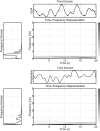A new approach for the quantification of synchrony of multivariate non-stationary psychophysiological variables during emotion eliciting stimuli
- PMID: 25653624
- PMCID: PMC4299432
- DOI: 10.3389/fpsyg.2014.01507
A new approach for the quantification of synchrony of multivariate non-stationary psychophysiological variables during emotion eliciting stimuli
Abstract
Emotion eliciting situations are accompanied by changes of multiple variables associated with subjective, physiological and behavioral responses. The quantification of the overall simultaneous synchrony of psychophysiological reactions plays a major role in emotion theories and has received increased attention in recent years. From a psychometric perspective, the reactions represent multivariate non-stationary intra-individual time series. In this paper, a new time-frequency based latent variable approach for the quantification of the synchrony of the responses is presented. The approach is applied to empirical data, collected during an emotion eliciting situation. The results are compared with a complementary inter-individual approach of Hsieh et al. (2011). Finally, the proposed approach is discussed in the context of emotion theories, and possible future applications and limitations are provided.
Keywords: coherence; emotion regulation; frequency; latent variables; multivariate; psychophysiology; synchrony; time series.
Figures












Similar articles
-
Models and methods of emotional concordance.Biol Psychol. 2014 Apr;98:1-5. doi: 10.1016/j.biopsycho.2013.12.012. Epub 2014 Jan 3. Biol Psychol. 2014. PMID: 24394718
-
Physiological evidence of interpersonal dynamics in a cooperative production task.Physiol Behav. 2016 Mar 15;156:24-34. doi: 10.1016/j.physbeh.2016.01.004. Epub 2016 Jan 7. Physiol Behav. 2016. PMID: 26773466
-
Psychophysiological Assessment of the Effectiveness of Emotion Regulation Strategies in Childhood.J Vis Exp. 2017 Feb 11;(120):55200. doi: 10.3791/55200. J Vis Exp. 2017. PMID: 28287585 Free PMC article.
-
Cognitive deficits in bipolar disorders: Implications for emotion.Clin Psychol Rev. 2018 Feb;59:126-136. doi: 10.1016/j.cpr.2017.11.006. Epub 2017 Nov 21. Clin Psychol Rev. 2018. PMID: 29195773 Free PMC article. Review.
-
Electrodermal and cardiovascular manifestations of emotions in children.J Physiol Anthropol Appl Human Sci. 2001 Mar;20(2):55-64. doi: 10.2114/jpa.20.55. J Physiol Anthropol Appl Human Sci. 2001. PMID: 11385939 Review.
Cited by
-
Interpersonal Physiological Synchrony for Detecting Moments of Connection in Persons With Dementia: A Pilot Study.Front Psychol. 2021 Dec 13;12:749710. doi: 10.3389/fpsyg.2021.749710. eCollection 2021. Front Psychol. 2021. PMID: 34966322 Free PMC article.
-
Exploring the Dynamics of Canine-Assisted Interactions: A Wearable Approach to Understanding Interspecies Well-Being.Animals (Basel). 2024 Dec 16;14(24):3628. doi: 10.3390/ani14243628. Animals (Basel). 2024. PMID: 39765532 Free PMC article.
References
-
- Acharya U. R., Joseph K. P., Kannathal N., Lim C. M., Suri J. S. (2006) Heart rate variability: a review. Med. Biol. Eng. Comput. 44, 1031–1051. - PubMed
-
- Brigham E. O. (2002). The Fast Fourier Transform. New York, NY: Prentice-Hall.
-
- Barrett L. F., Russell J. A. (1998). Independence and bipolarity in the structure of current affect. J. Pers. Soc. Psychol. 74, 967–984 10.1037/0022-3514.74.4.967 - DOI
-
- Bendat J., Piersol A. (1990). Random Data: Analysis and Measurement Procedures. New York, NY: John Wiley & Sons, Inc.
LinkOut - more resources
Full Text Sources
Other Literature Sources

